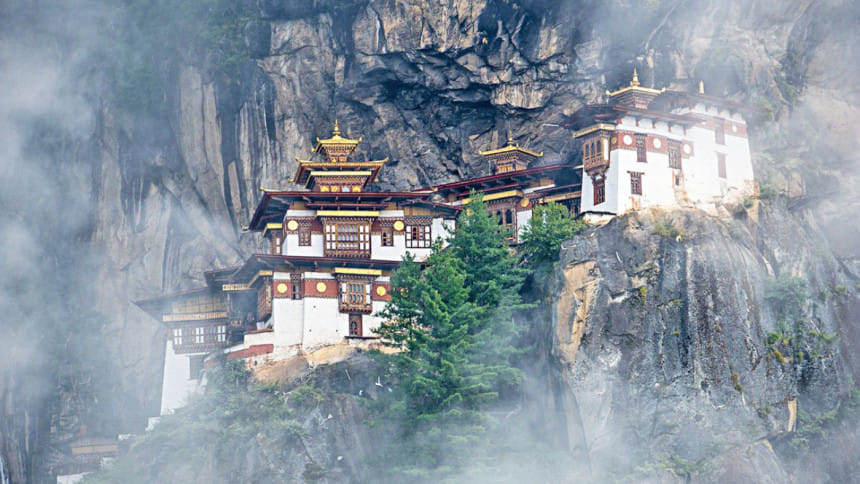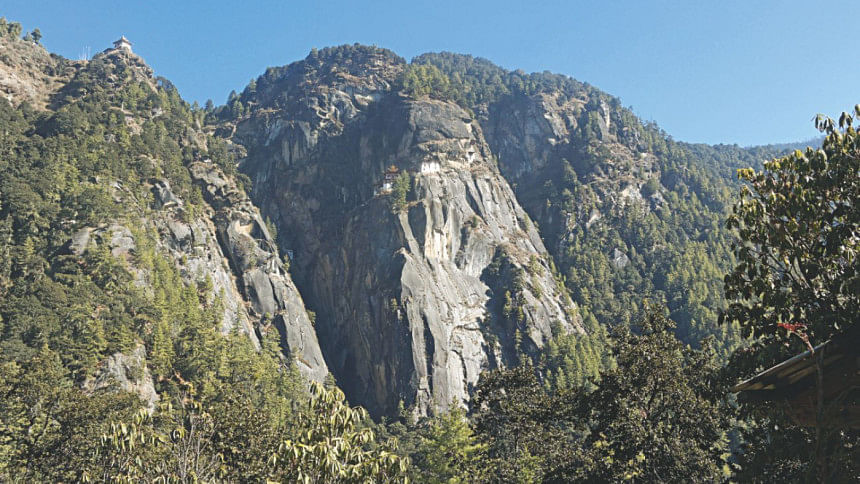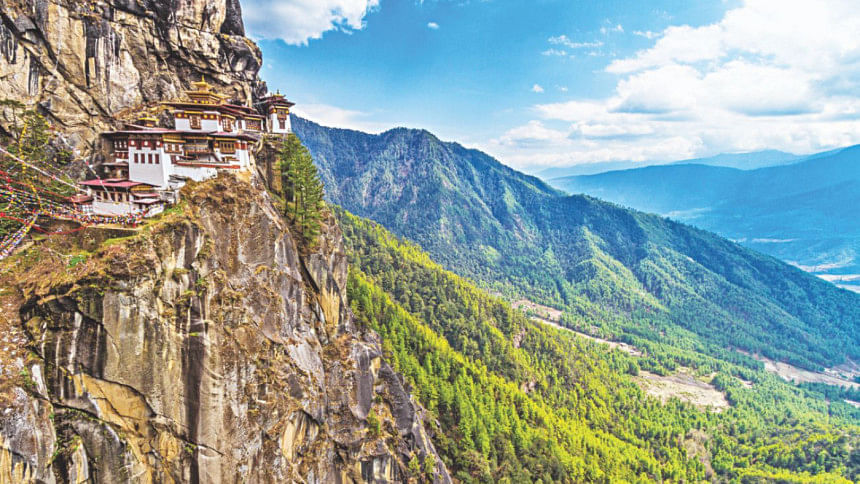The Climb to Tiger's Nest

Tiger's Nest, more properly known as Taktsang Palphug Monastery or Paro Taktsang, is the most well-known of the many pit-stops Guru Padmasambhava made while going about Bhutan spreading the word of the Buddha on his flying tiger. This Taktsang is a cave on a cliffside along the Upper Paro Valley and the Bhutanese have honoured this sacred location by constructing a fairly impressive temple around it. Despite it being, you know, high up on the face of a sheer mountain. In Bhutan, they believe that going out of your way for religion is meritorious, but it's toiling on the poor tourists' legs.
The trek is a two-stage one. You'll walk halfway up a fairly pleasant path strewn with prayer flags to a resting spot with a cafeteria near a temple similarly placed on a plateau projecting over the ravine. It is possible to hire, as the Bhutanese claim, horses which are actually mules to take you up to the cafeteria. Our guide was placed on a stubborn, flatulent beast named Kezong, who by dint of taking an unsupervised shortcut found himself at the front – a position he wasn't meant to occupy owing to his tendency to stop and stand there every thirty seconds. My mule was just behind and would spur Kezong on by rubbing his head on Kezong's bottom. At one point where the path turned quite sheer Kezong stood still longer than usual which allowed my mother's mule to catch up, and then the two steeds competed for the privilege of headbutting Kezong's rump. The tussle nearly ended with my mule pushing my mother off the ravine.
Animals are the strongest argument against vegetarianism.

After leaving your steeds at the halfway temple you can catch a cup of tea at the cafeteria and see Tiger's Nest taunting you from across the ravine. It looks a long way away. I found that it really isn't and I, unfit as I am, could make it up the mountain and through the forest in under an hour. That said, climbing up takes its toll on a body, and I wasn't helped by being weighed down by quite a lot of winter gear. I couldn't really do without any of it because it gets quite cold in the tree shade so high up, and yet the altitude puts you so much closer to the sun and the exercise heats you up. Clothe yourself with the expectation of being alternately hot and cold, and carry two bottles of water each. Convenient taps running with streamwater do exist on the path. At the very top you'll find proper stairs and railings that lead you down the valley and up again to the other side of the ravine to the Taktsang. You get the best view of the monastery from here; photos show it looking particularly striking during the rainy season but I wouldn't recommend the climb in that weather.

You will pass by a waterfall at the bottom; in winter this will be raining ice which collects in a nice heap of white at the base of the monastery's cliff. The stairs start getting very fancy from this stage of the climb and you can admire the icicles clinging to the cliff's underside as you walk up to the monastery itself. It's quite nice in there but they didn't allow photography so I can't show you. It's essentially a series of buildings with devotional rooms. Each contains the usual Buddhist paraphernalia of candles, offerings, paintings, and statues of important figures and their monstrous aspects. All very splendid in their colours; think mostly brown, gold and green. Quite a lot of gold is in evidence, with even gold dust mixed into the paint of the tapestries. Our guide made his prostrations and offerings before the images in each room, and a monk would pour a medicinal, Vicks-like substance on his palms to drink. Gave us some as well, which was lovely of him.

As is common in Bhutan, the structures are almost exclusively wooden, and I'd previously visited a monastery near Paro that'd completely burned down in a butterlamp-related accident. The Taktsang itself had similarly burned down in 1988 and finished its restoration as recently as 2005. The tourist needn't worry, though: they have fire extinguishers now.
A further test of endurance and dexterity lies within the monastery complex if you wish to pop in and visit the cave itself, the one visited by the Guru and his tiger. This is accessed using a series of janky step-laddery things and it's quite dark down there. The cave isn't anything much, though. We left after this as the monks break for lunch at 1.
Climbing down is much easier and the halfway cafeteria serves some quite nice chili-in-cheese. Treat yourself.
Zoheb Mashiur is a prematurely balding man with bad facial hair and so does his best to avoid people. Ruin his efforts by writing to [email protected]

 For all latest news, follow The Daily Star's Google News channel.
For all latest news, follow The Daily Star's Google News channel. 



Comments